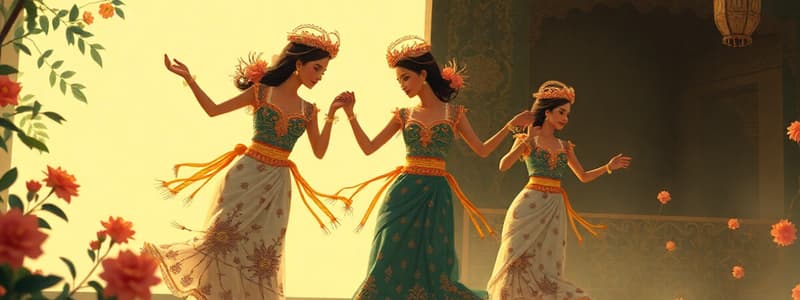Podcast
Questions and Answers
What are traditional dances?
What are traditional dances?
Dances of indigenous communities that show cultural traits of people in specific time and place.
The history of Philippine folk dancing only reflects influences from immigrants, not from within its own culture.
The history of Philippine folk dancing only reflects influences from immigrants, not from within its own culture.
False (B)
What did the people dance for before the Spanish conquest?
What did the people dance for before the Spanish conquest?
To appease the gods, curry favor from powerful spirits, celebrate a hunt or harvest, and mimic exotic life forms.
Which of the following dances is considered the Philippines' national dance?
Which of the following dances is considered the Philippines' national dance?
What does the Itik-Itik dance mimic?
What does the Itik-Itik dance mimic?
Where is the Sayaw sa Bangko dance performed?
Where is the Sayaw sa Bangko dance performed?
What is the main prop used in the Tinikling dance?
What is the main prop used in the Tinikling dance?
Pandanggo sa Ilaw is performed while balancing three ______.
Pandanggo sa Ilaw is performed while balancing three ______.
What type of dance is Carinosa?
What type of dance is Carinosa?
Ethnic dance refers only to classical dances in a nation.
Ethnic dance refers only to classical dances in a nation.
Match the following dances to their descriptions:
Match the following dances to their descriptions:
Flashcards are hidden until you start studying
Study Notes
Traditional Dances Overview
- Traditional dances represent the cultural traits of indigenous communities, preserving customs and traditions through specific dance steps and costumes.
- These dances are passed down through generations with established patterns.
- Philippine folk dancing reflects historical influences from immigrants and conquerors while maintaining a distinctly Filipino essence.
Pre-Colonial and Spanish Colonial Influence
- Before Spanish colonization, indigenous people danced for various purposes, including appeasing gods, celebrating hunts or harvests, and imitating nature.
- During the Spanish colonial period, folk dances evolved by incorporating Christian beliefs while retaining local traditions.
- Dancers adopted European styles but infused them with a Philippine spirit, often performing in 16th-century European attire while utilizing bamboo castanets.
Folk Dances Characteristics
- Folk dancing is recognized as a social dance, integral to the customs of villages and regions, with origins rooted in communal celebrations.
- Dances usually consist of basic formations, like circles or lines, enabling group movement.
Specific Folk Dances
- Itik-Itik: Mimics a duck's movements, created by a woman named Kanang at a baptismal party. It gained popularity as guests imitated her steps.
- Tinikling: Widely regarded as the Philippines' national dance, mimics the tikling bird's movements, performed using bamboo poles with singles, doubles, and hops.
- Sayaw sa Bangko: Performed on a narrow bench requiring balance and acrobatic movements, rooted in the regions of Lingayen and Pangasinan.
- Pandanggo sa Ilaw: A lively dance from Lubang Island, where dancers balance three oil lamps while moving to music in 3/4 time, accompanied by castanets.
- Carinosa: A flirtatious dance that involves dancers hiding behind fans or handkerchiefs, symbolizing courtship.
Ethnic Dances
- Ethnic dance encompasses dance forms from ethnic cultures, showcasing their aesthetics through classical and contemporary styles.
Specific Ethnic Dances of the Talaandig Tribe
- Binanog: Mimics a bird's movements, illustrating aerial grace.
- Inagong: An entertainment dance performed during festivals and gatherings.
- Saot: A male dance displaying fighting skills and rituals in honor of the god Magbabaya.
- Tinambol: Performed by both genders for entertainment and in rituals honoring Magbabaya.
- Dugso: A ceremonial dance among the Manobo people, performed by women during religious celebrations.
Studying That Suits You
Use AI to generate personalized quizzes and flashcards to suit your learning preferences.




